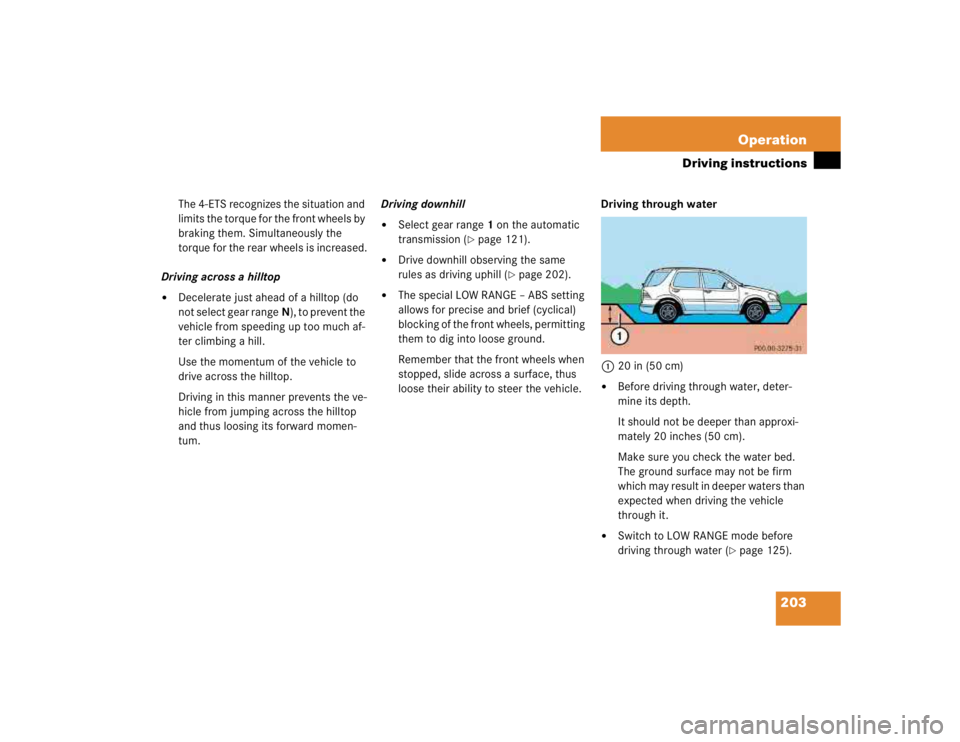Page 800 of 4133
Courtesy of MERCEDES-BENZ OF NORTH AMERICA.
WIRE REPAIR
DO NOT repair wiring harness. Replace complete SRS wiring harn ess, if any part is damaged.
TORQUE SPECIFICATIONS
TORQUE SPECIFICATIONS
DIAGNOSTICS
Air bag system diagnostic information is not available. All air bag system diagnosis must be carried out using
manufacturers proprietary STAR diagnostic tool.
WIRING DIAGRAMS
ApplicationFt. Lbs. (N.m)
Front ETR
Belt end fitting26 (35)
Belt height adjuster bolt18 (25)
Bolts22 (30)
Rear ETR
Belt height adjuster bolt22 (30)
Bolts22 (30)
INCH Lbs. (N.m)
Control module bolts(1)
Driver-side air bag module bolts71 (8)
Head impact air bag module bolts71 (8)
Passenger-side air bag module nuts71 (8)
Side impact sensor screws(1)
(1)Information is not available.
2004 Mercedes-Benz ML350
2004 ACCESSORIES/SAFETY EQUIPMENT Merce des-Benz - Air Bag Restraint Systems
me
Saturday, October 02, 2010 3:40:40 PMPage 15 © 2006 Mitchell Repair Information Company, LLC.
Page 1007 of 4133

203 Operation
Driving instructions
The 4-ETS recognizes the situation and
limits the torque for the front wheels by
braking them. Simultaneously the
torque for the rear wheels is increased.
Driving across a hilltop
�
Decelerate just ahead of a hilltop (do
not select gear rangeN), to prevent the
vehicle from speeding up too much af-
ter climbing a hill.
Use the momentum of the vehicle to
drive across the hilltop.
Driving in this manner prevents the ve-
hicle from jumping across the hilltop
and thus loosing its forward momen-
tum.Driving downhill
�
Select gear range1 on the automatic
transmission (
�page 121).
�
Drive downhill observing the same
rules as driving uphill (
�page 202).
�
The special LOW RANGE – ABS setting
allows for precise and brief (cyclical)
blocking of the front wheels, permitting
them to dig into loose ground.
Remember that the front wheels when
stopped, slide across a surface, thus
loose their ability to steer the vehicle.Driving through water
120 in (50 cm)
�
Before driving through water, deter-
mine its depth.
It should not be deeper than approxi-
mately 20 inches (50 cm).
Make sure you check the water bed.
The ground surface may not be firm
which may result in deeper waters than
expected when driving the vehicle
through it.
�
Switch to LOW RANGE mode before
driving through water (
�page 125).
Page 1033 of 4133
229 Operation
Tires and wheels
Warning!
G
Have the tightening torque checked after
changing a wheel. Wheels could become
loose if not tightened with a torque of
110 lb-ft (150 Nm).
Use only genuine Mercedes-Benz wheel
bolts specified for your vehicle's rims.
Page 1081 of 4133
277 Practical hints
Flat tire
1-5Wheel bolts�
Tighten the five wheel bolts evenly, fol-
lowing the diagonal sequence illustrat-
ed (1 to 5), until all bolts are tight.
Observe a tightening torque of
110 lb-ft (150 Nm).
�
Store jack and tool kit.Warning!
G
Have the tightening torque checked after
changing a wheel. The wheels could come
loose if they are not tightened to a torque of
110 lb-ft (150 Nm).iThe removed road wheel cannot be
stored in the spare wheel carrier, but
should be transported in the rear cargo
compartment wrapped in a protective
cover supplied with the vehicle.
The protective cover is located in the
rear cargo compartment behind the
cover in the right side trim panel.
Page 1098 of 4133
294 Technical dataEngine
�EngineModel
ML 350 (163.157
1)
1The quoted data apply only to the standard vehicle. See an authorized Mercedes-Benz Light Truck Center for the corresponding data of all special bodies and special
equipment.
ML 500 (163.175)
1
Engine
112
113
Mode of operation
4-stroke engine, gasoline injection
4-stroke engine, gasoline injection
No. of cylinders
6
8
Bore
3.81 in (97.00 mm)
3.81 in (97.00 mm)
Stroke
3.31 in (84.00 mm)
3.31 in (84.00 mm)
Total piston displacement
227 cu in (3724 cm
3)
303 cu in (4966 cm
3)
Compression ratio
10:1
10:1
Output acc. to SAE J 1349
232 hp / 5750 rpm
(173 kW / 5750 rpm)
288 hp / 5600 rpm
(215 kW / 5600 rpm)
Maximum torque acc. to SAE J 1349
254 lb-ft / 3000-4500 rpm
(345 Nm / 3000-4500 rpm)
325lb-ft/2700rpm
(440 Nm / 2700 rpm)
Maximum engine speed
6000 rpm
6000 rpm
Firing order
1-4-3-6-2-5
1-5-4-2-6-3-7-8
Poly-V-belt
2370 mm
2370 mm
Page 1101 of 4133
297 Technical data
Electrical system
�Electrical system
Model
ML 350
ML 500
Generator (alternator)
14 V / 120 A
14 V / 150 A
Starter motor
12 V / 1.7 kW
12 V / 1.7 kW
Battery
12 V / 100 Ah
12 V / 100 Ah
Spark plugs
Bosch F 8 DPP332
Bosch F 8 DPER
Bosch F 8 DPP332
Bosch F 8 DPER
Electrode gap
0.039 in (1.0 mm)
0.039 in (1.0 mm)
Tightening torque
15 – 22 lb-ft (20 – 30 Nm)
15 – 22 lb-ft (20 – 30 Nm)
Page 1118 of 4133

314 Technical termsPoly-V-belt drive
Drives engine-components (alternator,
AC compressor, etc.) from the engine.
Power train
Collective term designating all compo-
nents used to generate and transmit
motive power to the drive axles, includ-
ing
�
engine
�
clutch / torque converter
�
transmission
�
transfer case
�
drive shaft
�
differential
�
axle shafts / axlesRemote Vehicle Diagnostics
Transmission of vehicle data and cur-
rent location to the Mercedes-Benz
Customer Assistance Center for sub-
scribers to Tele Aid service.
REST
(Residual engine heat utilization)
Feature that uses the engine heat
stored in the coolant to heat the vehi-
cle interior for a short time after the en-
gine has been turned off.
Restraint system
Seat belts, belt tensioner, airbags and
child seat restraint systems. As inde-
pendent systems, their protective func-
tions complement one another.RON
(R
esearch O
ctane N
umber)
The Research Octane Number for gaso-
line as determined by a standardized
method. It is an indication of a gaso-
line's ability to resist undesired detona-
tion (knocking). The average of both
the ->MON (Motor Octane Number)
and RON (Research Octane Number) is
posted at the pump, also known as
ANTI-KNOCK INDEX.
Shift lock
When the vehicle is parked, this lock
prevents the transmission selector le-
ver from being moved out of positionP
without key turned and brake pedal de-
pressed.
SRS
(S
upplemental R
estraint S
ystem)
Seat belts, emergency tensioning de-
vice and airbags. Though independent
systems, they are closely interfaced to
provide effective occupant protection.
Page 1119 of 4133

315 Technical terms
Tele Aid System*
(T
elematic A
larm I
dentification on
D
emand)
The Tele Aid system consists of three
types of response: automatic and man-
ual emergency, roadside assistance
and information. Tele Aid is initially ac-
tivated by completing a subscriber
agreement and placing an acquain-
tance call.
The Tele Aid system is operational pro-
vided that the vehicle’s battery is
charged, properly connected, not dam-
aged and cellular and GPS coverage is
available.
Telematics*
A combination of the terms “telecom-
munications” and “informatics”.
Tightening torque
Force times lever arm (e.g. a lug
wrench) with which threaded fasteners
such as wheel bolts are tightened.Tire speed rating
Part of tire designation; indicates the
speed range for which a tire is ap-
proved.
Traction
Force exerted by the vehicle on the
road via the tires.
Transfer case
Speed of rotation / torque converter
that works together with the ->auto-
matic transmission. In the LOW mode
off-road position, the transfer case de-
creases the output rotational speed of
the ->automatic transmission by ap-
proximately half. This results in a corre-
sponding increase of torque on the
drive axles.
The vehicle then has nearly double the
driving force but drives only approxi-
mately half as fast.TWR
(T
ongue W
eight R
ating)
The TWR is the maximum permissible
weight on the trailer tongue.
VIN
(V
ehicle I
dentification N
umber)
The number set by the manufacturer
and placed on the body to uniquely
identify each vehicle produced.
Voice control system*
Voice control system for car phones,
portable cell phones and audio sys-
tems (radio, CD, etc.).